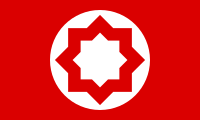| Islamic Nations Party | |
|---|---|
 | |
| Leaders | Kazem Mousavi-Bojnourdi (POW) |
| Dates of operation | late 1950s[1]–late 1960s[2] Main phase: 1963–1965[1] |
| Headquarters | Tehran, Iran |
| Ideology | |
| Political position | Far-left |
| Size | ~200[1] |
| Allies | |
| Opponents | |
| Battles and wars | Iranian Revolution |
Islamic Nations Party or Party of Islamic Nations (Persian: حزب ملل اسلامی, romanized: Ḥezb-e melal-e eslāmi) was an Islamic leftist armed group with clandestine system[9] short-lived during 1960s. It was initially a secret society active against Pahlavi dynasty in late 1950s.[1] It consisted of middle-class youth, mostly highschool teachers and university students.[1]
The organization was reportedly involved in 1963 events and 1965 assassination of Hassan Ali Mansur.[7][6] However, it is alleged that opening fire on Police before arrest of leading members was its "sole standoff".[1]
After a visit to Iraq, leader Mousavi-Bojnourdi brought two firearms for the planned bank robbery and kidnapping. A rank-and-file member was arrested accidentally and led security forces to a 140-men list of the members.[1] A cache of arms belonging to the party was also discovered in the hills of north Tehran.[6]
55 members of the group were arrested in 1965[1] and received long-term confinements in 1966 by military tribunal. Four members were executed[6] and death sentence of the leader Mousavi-Bojnourdi reduced to life in prison.[1]
A number of Revolutionary Guards commanders including Javad Mansouri, Abbas Zamani and Abbas Duzduzani were members of the group.[5]
References[edit]
- ^ a b c d e f g h i j k l Vahabzadeh, Peyman (2010). "Islamic Nations Party". Guerrilla Odyssey: Modernization, Secularism, Democracy, and the Fadai Period of National Liberation In Iran, 1971-1979. Syracuse University Press. pp. 9–10. ISBN 9780815651475.
- ^ Taheri, Amir (1986). The Spirit of Allah: Khomeini and the Islamic revolution. Adler & Adler. p. 187. ISBN 9780917561047.
- ^ a b Torāb Ḥaqšenās (April 5, 2012) [December 15, 2007]. "ISLAM IN IRAN xiii. ISLAMIC POLITICAL MOVEMENTS IN 20TH CENTURY IRAN". In Ashraf, Ahmad (ed.). Encyclopædia Iranica. Fasc. 2. Vol. XIV. New York City: Bibliotheca Persica Press. pp. 157–172. Retrieved March 15, 2016.
- ^ a b Bashiriyeh, Hossein (27 April 2012). The State and Revolution in Iran (RLE Iran D). Taylor & Francis. pp. 13–14. ISBN 9781136820892.
- ^ a b Steven O'Hern (2012). Iran's Revolutionary Guard: The Threat That Grows While America Sleeps. Potomac Books, Inc. pp. 18, 22–23. ISBN 978-1597977012.
- ^ a b c d e Said Amir Arjomand (1984). From Nationalism to Revolutionary Islam. SUNY Press. p. 167. ISBN 9780873958707.
- ^ a b Mehrzad Boroujerdi (1996). Iranian Intellectuals and the West: The Tormented Triumph of Nativism. Syracuse University Press. pp. 83–84. ISBN 978-0-8156-0433-4.
- ^ Torāb Ḥaqšenās (October 27, 2011) [December 15, 1992]. "COMMUNISM iii. In Persia after 1953". In Yarshater, Ehsan (ed.). Encyclopædia Iranica. Fasc. 1. Vol. VI. New York City: Bibliotheca Persica Press. pp. 105–112. Retrieved March 15, 2016.
- ^ Marvin Zonis (2015). Political Elite of Iran. Princeton University Press. p. 115. ISBN 9781400868803.
Well, that’s interesting to know that Psilotum nudum are known as whisk ferns. Psilotum nudum is the commoner species of the two. While the P. flaccidum is a rare species and is found in the tropical islands. Both the species are usually epiphytic in habit and grow upon tree ferns. These species may also be terrestrial and grow in humus or in the crevices of the rocks.
View the detailed Guide of Psilotum nudum: Detailed Study Of Psilotum Nudum (Whisk Fern), Classification, Anatomy, Reproduction